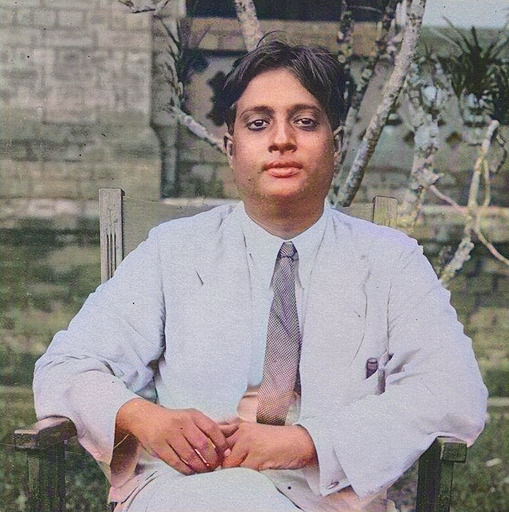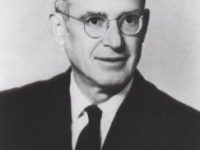
Satyendra Nath Bose (1894-1974)
On January 1, 1898, Bengali Indian physicist Satyendra Nath Bose was born. Specialising in mathematical physics, Bose is best known for his work on quantum mechanics in the early 1920s, providing the foundation for Bose–Einstein statistics and the theory of the Bose–Einstein condensate. The class of particles that obey Bose–Einstein statistics, bosons, was named after Bose by Paul Dirac.
“You don’t know who he was? Half the particles in the universe obey him!”
[Reply by a physics professor when a student asked who Bose was.]
— Anonymous, quoted in ‘Original Vision, Forgotten Hero’, The Calcutta Telegraph (3 Jan 2012)
Education
Bose was born in Calcutta (now Kolkata), the eldest of seven children and the only son of Surendranath Bose, an accountant and entrepreneur who later set up his own chemical and pharmaceutical company. Satyendranath began his education at an elementary school in Calcutta before entering the Hindu School in 1907. It was here that his interest in mathematics and science began, and as is so often the case, it was due to an outstanding mathematics teacher coupled with encouragement from the headmaster.[1] Bose chose mixed (applied) mathematics for his BSc and passed the examinations standing first in 1913 and again stood first in the MSc mixed mathematics exam in 1915. After completing his MSc, Bose joined the University of Calcutta as a research scholar in 1916 and started his studies in the theory of relativity.
Academic Career
As a polyglot, Bose was well versed in several languages such as Bengali, English, French, German and Sanskrit as well as the poetry of Lord Tennyson, Rabindranath Tagore and Kalidasa.[4,5] From 1916 to 1921, he was a lecturer in the physics department of the University of Calcutta. Along with Saha, Bose prepared the first book in English based on German and French translations of original papers on Einstein’s special and general relativity in 1919. Bose was appointed as a Reader in physics at the University of Dacca in 1921 and taught there until 1945, being a professor and head of the physics department from 1927. In 1945 he returned to Calcutta University when he was appointed as Guprasad Sing Professor of Physics, a position he held until he retired in 1956 when he was made Professor Emeritus.[1]
Bose’s Interpretation
While presenting a lecture at the University of Dhaka on the theory of radiation and the ultraviolet catastrophe, Bose intended to show his students that the contemporary theory was inadequate, because it predicted results not in accordance with experimental results. In the process of describing this discrepancy, Bose for the first time took the position that the Maxwell–Boltzmann distribution would not be true for microscopic particles, where fluctuations due to Heisenberg’s uncertainty principle will be significant. Bose adapted this lecture into a short article called Planck’s Law and the Hypothesis of Light Quanta and sent it to Albert Einstein.[6] Einstein agreed with him, translated Bose’s paper “Planck’s Law and Hypothesis of Light Quanta” into German, and had it published in Zeitschrift für Physik as “Plancks Gesetz und Lichtquantenhypothese” [7] under Bose’s name, in 1924. The reason Bose’s interpretation produced accurate results was that since photons are indistinguishable from each other, one cannot treat any two photons having equal energy as being two distinct identifiable photons.
The Bose-Einstein Condensate
An important consequence of Einstein’s response to Bose’s article was that his application to the University of Dacca for two years research leave beginning in 1924 was approved. He now had the chance of meeting European scientists and travelled first to Paris where he met Langevin [12] and de Broglie.[13] In October 1925 Bose travelled from Paris to Berlin where he met Einstein. Much progress had been made by Einstein following his receipt of Bose’s paper for he was able to see how the ideas could be taken forward. While he was in Berlin Bose attended a course on quantum theory given by Max Born.[14,1] Einstein adopted the idea and extended it to atoms. This led to the prediction of the existence of phenomena which became known as Bose–Einstein condensate, a dense collection of bosons (which are particles with integer spin, named after Bose), which was demonstrated to exist by experiment in 1995.[2]
The Einstein-Bose Statistics
Bose published on statistical mechanics leading to the Einstein-Bose statistics.[16] Dirac [11] coined the term boson for particles obeying these statistics. Through these terms his name is rightly known and remembered, for indeed his contributions are remarkable, especially given the fact that he made his important discoveries working in isolation from the mainstream developments in Europe. Apart from physics, he did some research in biotechnology and literature (Bengali and English). He made deep studies in chemistry, geology, zoology, anthropology, engineering and other sciences. S.N. Bose several times was nominated for the Nobel Prize in Physics, for his contribution to Bose-Einstein Statistics and Unified Field Theory. Although several Nobel Prizes were awarded for research related to the concepts of the boson, Bose–Einstein statistics and Bose–Einstein condensate, Bose himself was not awarded a Nobel Prize. In 1958, Bose became Fellow of the Royal Society.
Satyendra Nath Bose died on February 4, 1974 in Calcutta, India, aged 80.
Tonya Coffey, Bose Einstein Statistics, [10]
References and Further Reading:
- [1] O’Connor, John J.; Robertson, Edmund F., “Satyendra Nath Bose“, MacTutor History of Mathematics archive, University of St Andrews.
- [2] The Bose-Einstein Condensate brings Quantum Theory to the Macroscopic Scale, SciHi blog
- [3] Satyendra Nath Bose, Indian physicist, at Britannica online
- [4] Victorian Poetry with Alfred Lord Tennyson, SciHi Blog
- [5] Reshaping India’s Literature – Rabindranath Tagore, SciHi Blog
- [6] Albert Einstein revolutionized Physics, SciHi Blog
- [7] Bose (1924), “Plancks Gesetz und Lichtquantenhypothese“, Zeitschrift für Physik (in German), 26 (1): 178–181
- [8] Works by or about Satyendra Nath Bose at Internet Archive
- [9] Satyendra Nath Bose at Wikidata
- [10] Tonya Coffey, Bose Einstein Statistics, Statistical Physics, Part 7, Tonya Cofey @ youtube
- [11] Paul Dirac and the Quantum Mechanics, SciHi Blog
- [12] Paul Langevin and the Langevin Dynamics, SciHi Blog
- [13] Louis de Broglie and wave nature of matter, SciHi Blog
- [14] Max Born and the statistical interpretation of the Wave Function, SciHi Blog
- [15] Mehra, J. (1975). “Satyendra Nath Bose 1 January 1894 – 4 February 1974”. Biographical Memoirs of Fellows of the Royal Society. 21: 116–126.
- [16] Masters, Barry R. (April 2013). “Satyendra Nath Bose and Bose–Einstein Statistics” . Optics & Photonics News. 24 (4): 41.
- [17] Bal, Hartosh Singh (19 September 2012). “The Bose in the Boson”. New York Times blog.
- [18] Timeline for Satyendra Nath Bose, via Wikidata






Pingback: Whewell’s Gazette: Year 3, Vol. #21 | Whewell's Ghost